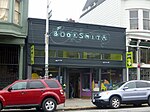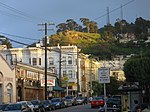Haight Street Grounds
1887 establishments in California1895 disestablishments in CaliforniaBaseball venues in CaliforniaDefunct baseball venues in the United StatesDefunct college football venues ... and 5 more
Demolished sports venues in CaliforniaHistory of San FranciscoSports venues completed in 1887Sports venues demolished in 1895Sports venues in San Francisco
Haight Street Grounds was one of San Francisco's earliest baseball parks; it was also used for college football. It opened in 1887 and was demolished in 1895.
Excerpt from the Wikipedia article Haight Street Grounds (License: CC BY-SA 3.0, Authors).Haight Street Grounds
Shrader Street, San Francisco
Geographical coordinates (GPS) Address Nearby Places Show on map
Geographical coordinates (GPS)
| Latitude | Longitude |
|---|---|
| N 37.767547222222 ° | E -122.45151666667 ° |
Address
Shrader Street 757;759;761
94117 San Francisco
California, United States
Open on Google Maps








